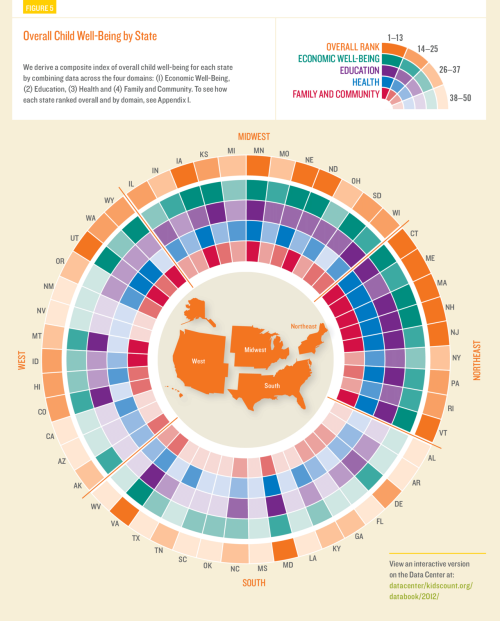What a Difference a State Makes! How America’s Children are Faring in the Aftermath of the Recession
Despite our economic woes, America’s children still managed to make gains in academic achievement and health in recent years. But with one in three children lacking parents with secure employment and poverty predicted to reach a 46-year high later this year, children’s overall well-being continues to be in jeopardy. Most striking is how much children’s fortunes differ depending on the state in which they live, according to the Annie E. Casey Foundation’s 2012 KIDS COUNT Data Book.
Between roughly 2005 and 2010, improvements in children’s health and education included a 20 percent decrease in the number of kids without health insurance; a 16 percent drop in the child and teen death rate; an 11 percent reduction in the rate of high school students not graduating in four years; and an 8 percent reduction in the proportion of eighth-graders scoring less than proficient in math.
But during the same period, the percent of children living in poverty rose from 19 to 22 percent – an increase of 2.4 million kids. At about $22,000 a year for a family of four, a poverty-level income is inadequate to meet a family’s basic needs. Studies indicate that families need at least twice that much to make ends meet, yet in 2010, a startling 44 percent of children lived in families with incomes below twice the poverty level.
This year’s Data Book tracks child well-being using 16 indicators organized into four categories: Economic Well-Being, Education, Health, and Family and Community. I'll be blogging about how kids are doing in each of these domains over the next several weeks. The report also provides a ranking of overall child well-being by state. The three highest ranked states are New Hampshire, Massachusetts and Vermont, while the three lowest ranked states are Nevada, New Mexico and Mississippi.
State differences in child well-being reflect variation in state wealth and other resources, as well as state policy choices that influence children’s chances for success. As the map shows, distinct regional patterns emerge from the state rankings. All of the northeastern states rank in the top 15 in terms of overall child well-being except for Rhode Island and New York, both of which fall in the middle. States in the industrial Midwest rank in the middle on overall child well-being, while some of the states farther west – Minnesota, North Dakota, Iowa and Nebraska – are in the top 10.
States in the Southeast, Southwest and Appalachia – where household income is the lowest in the country – populate the bottom of the overall rankings. In fact, with the exception of California, the 17 lowest ranked states in terms of child well-being are located in these regions.
If we want to ensure that the next generation is prepared to effectively compete in a global economy we must make smart investments so that all children, not just those living in the most supportive states, reach their full potential.
Next up... How states are doing in children's economic well being.


The views and opinions expressed in this post are those of the author(s) and do not necessarily reflect those of MomsRising.org.
MomsRising.org strongly encourages our readers to post comments in response to blog posts. We value diversity of opinions and perspectives. Our goals for this space are to be educational, thought-provoking, and respectful. So we actively moderate comments and we reserve the right to edit or remove comments that undermine these goals. Thanks!